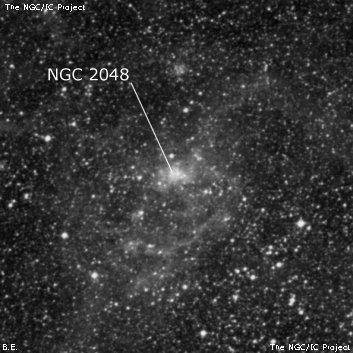
NGC 2048 is situated in a glorious region of the LMC; extending to the southwest is NGC 2033 = LH 81, a large stellar association (the stars on the south side of the semicircular chain are likely members) and further north is NGC 2055 = LH 96, a huge rich cloud just south of the Tarantula Nebula.
John Herschel discovered NGC 2048 = h2926 in 1834-1835 (exact sweep or date unknown as based on a sketch of the Tarantula Nebula (NGC 2070) region made over several nights in Nov 1834 and Dec 1835) and described as "a very faint large oval ill-defined nebula; not taken in sweeping, but laid down from a careful drawing. See Notes on Catalogue of Nubecula Major". His position is 3' NE of the center of this nebula. Hodge and Wright describe it as "possibly only 2-3 stars in nebulosity" in their LMC Atlas.
300/350mm - 14" (4/4/16 - Coonabarabran, 145x + NPB filter): NGC 2048 is a bright elongated glow, ~1'x0.7' E-W, surrounded by fainter nebulous haze extending 3'-4' in diameter. The emission component (LHA 120-N 154A) is cradled around the south and east side by a large, semicircular chain with mostly mag 12 stars and a total length of ~15' (association LH 87). At the west end of this chain is HD 37836, a mag 10.6 emission-line B0 star.
Notes by Steve Gottlieb